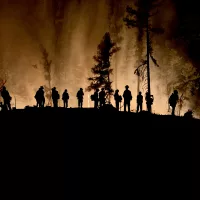
After a record-breaking year, all Oregon Department of Forestry districts have terminated fire restrictions, marking the end of the 2024 Oregon fire season declaration. With over 1.9 million acres burned across the state, firefighters and resources experienced extreme strain.
“This season proved that wildfire in Oregon is not just one agency’s issue but effects ALL Oregonians from government agencies to private landowners to Oregon residents.” Kyle Williams, ODF Deputy Director of Fire Protection, said, “This is our reality, and we need to adjust in response to it.”
Throughout May and June, the state experienced an average, even below average, season. However, early July brought the beginning of peak season with a heat wave followed by several lightning and wind events that primarily affected Central and Eastern Oregon.
Meteorological events combined with lightning-and human-caused fire brought immense strain on Oregon’s in-state resources. In response, the department leaned heavily into its interstate relationships. Firefighters and resources from about 20 states and Canada were brought to Oregon through state-to-state mutual aid agreements and the Northwest Compact.
“The outpouring of support from out of state has been amazing to say the least,” Chris Cline, ODF Protection Division Chief, said. “It truly goes to show that fire is a family, no matter where you are.”
Year to date, there have been 1,003 fires on ODF-protected lands resulting in 314,181 acres burned. ODF Type 1 Incident Management Teams (IMT) have been mobilized 11 times to wildfires this year. The assignments were to the following incidents:
- Salt Creek Fire
- Larch Creek Fire
- Dixon Fire
- Boneyard & Court Rock Fires
- Battle Mountain Complex
- Lane 1 Fire
- Copperfield Fire
- Shoe Fly Fire
- Fossil Complex (two deployments)
- Winding Water Complex
An ODF team was also deployed earlier in the year to assist Lane County and Springfield in their ice storm response. The department also mobilized a Complex IMT comprised of North Carolina and Florida firefighters through state-to-state mutual aid agreements. Statewide, regardless of jurisdiction, there have been 1,956 fires that have burned 1,937,512 acres.
Due to the agency’s aggressive approach to initial attack to preserve natural resources, protect communities, and increase firefighter safety, many fire starts that happened this year were never heard about. Overall, the department put out 93 percent of fires on ODF-protected land at 10 acres or fewer this year.
Fighting alongside ODF and other wildland firefighters this season were members of Rangeland Fire Protection Associations. Rangeland Fire Protection Associations (RFPAs) are independent, non-profit, volunteer fire organizations that provide local fire protection in rural Oregon, usually in areas outside of local fire district protection.
There are 28 RFPAs that protect rangeland and are an integral part of Oregon’s complete and coordinated system. This season, RFPAs were some of the first resources to respond and begin work on a fire while more resources were on their way. They also provided incident management teams and fire managers with information on the area and the land that gave in-depth situational awareness and influenced operations. ODF supports the associations through administrative guidance, insurance reimbursement, fire suppression training and facilitating access to federal grants and surplus firefighting equipment.
The start and end of fire season restrictions and regulations are set by each forest protection district based on the conditions in their area including drought, climatic forecasts, and seasonal trends. These restrictions and regulations are on activities prone to start wildfires, such as debris burning and certain equipment use, and are intended as preventative measures during times with elevated wildfire risks. The arrival of steady soaking rain, coupled with cooler temperatures and shorter days, usually triggers the closure of fire season. The end of fire season removes ODF imposed fire restrictions on ODF-protected lands. However, many structural fire departments in Oregon still require a permit for debris burning, and slash burning requires a permit year-round, so check with your local fire department or ODF office before starting a burn.
As Oregon transitions out of fire season, ODF districts across the state are shifting their attention to wildfire prevention, fuels reduction, mitigation and planning efforts.
For more tips on how to keep yourself, your loved ones and your property safe from wildfire at any time of year, visit ODF’s Fire Prevention website or Keep Oregon Green’s website.
ODF protects over 16 million acres of private, county, state and federal forest and grazing lands in Oregon.















